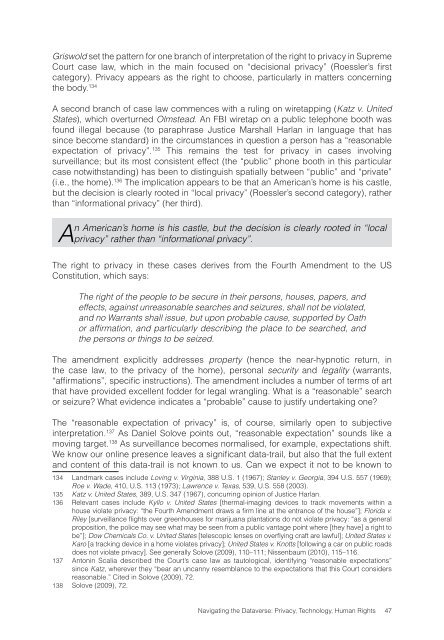Navigating the Dataverse: Privacy, Technology ... - The ICHRP
Navigating the Dataverse: Privacy, Technology ... - The ICHRP
Navigating the Dataverse: Privacy, Technology ... - The ICHRP
You also want an ePaper? Increase the reach of your titles
YUMPU automatically turns print PDFs into web optimized ePapers that Google loves.
Griswold set <strong>the</strong> pattern for one branch of interpretation of <strong>the</strong> right to privacy in Supreme<br />
Court case law, which in <strong>the</strong> main focused on “decisional privacy” (Roessler’s first<br />
category). <strong>Privacy</strong> appears as <strong>the</strong> right to choose, particularly in matters concerning<br />
<strong>the</strong> body. 134<br />
A second branch of case law commences with a ruling on wiretapping (Katz v. United<br />
States), which overturned Olmstead. An FBI wiretap on a public telephone booth was<br />
found illegal because (to paraphrase Justice Marshall Harlan in language that has<br />
since become standard) in <strong>the</strong> circumstances in question a person has a “reasonable<br />
expectation of privacy”. 135 This remains <strong>the</strong> test for privacy in cases involving<br />
surveillance; but its most consistent effect (<strong>the</strong> “public” phone booth in this particular<br />
case notwithstanding) has been to distinguish spatially between “public” and “private”<br />
(i.e., <strong>the</strong> home). 136 <strong>The</strong> implication appears to be that an American’s home is his castle,<br />
but <strong>the</strong> decision is clearly rooted in “local privacy” (Roessler’s second category), ra<strong>the</strong>r<br />
than “informational privacy” (her third).<br />
An American’s home is his castle, but <strong>the</strong> decision is clearly rooted in “local<br />
privacy” ra<strong>the</strong>r than “informational privacy”.<br />
<strong>The</strong> right to privacy in <strong>the</strong>se cases derives from <strong>the</strong> Fourth Amendment to <strong>the</strong> US<br />
Constitution, which says:<br />
<strong>The</strong> right of <strong>the</strong> people to be secure in <strong>the</strong>ir persons, houses, papers, and<br />
effects, against unreasonable searches and seizures, shall not be violated,<br />
and no Warrants shall issue, but upon probable cause, supported by Oath<br />
or affirmation, and particularly describing <strong>the</strong> place to be searched, and<br />
<strong>the</strong> persons or things to be seized.<br />
<strong>The</strong> amendment explicitly addresses property (hence <strong>the</strong> near-hypnotic return, in<br />
<strong>the</strong> case law, to <strong>the</strong> privacy of <strong>the</strong> home), personal security and legality (warrants,<br />
“affirmations”, specific instructions). <strong>The</strong> amendment includes a number of terms of art<br />
that have provided excellent fodder for legal wrangling. What is a “reasonable” search<br />
or seizure? What evidence indicates a “probable” cause to justify undertaking one?<br />
<strong>The</strong> “reasonable expectation of privacy” is, of course, similarly open to subjective<br />
interpretation. 137 As Daniel Solove points out, “reasonable expectation” sounds like a<br />
moving target. 138 As surveillance becomes normalised, for example, expectations shift.<br />
We know our online presence leaves a significant data-trail, but also that <strong>the</strong> full extent<br />
and content of this data-trail is not known to us. Can we expect it not to be known to<br />
134 Landmark cases include Loving v. Virginia, 388 U.S. 1 (1967); Stanley v. Georgia, 394 U.S. 557 (1969);<br />
Roe v. Wade, 410, U.S. 113 (1973); Lawrence v. Texas, 539, U.S. 558 (2003).<br />
135 Katz v. United States, 389, U.S. 347 (1967), concurring opinion of Justice Harlan.<br />
136 Relevant cases include Kyllo v. United States [<strong>the</strong>rmal-imaging devices to track movements within a<br />
house violate privacy: “<strong>the</strong> Fourth Amendment draws a firm line at <strong>the</strong> entrance of <strong>the</strong> house”]; Florida v.<br />
Riley [surveillance flights over greenhouses for marijuana plantations do not violate privacy: “as a general<br />
proposition, <strong>the</strong> police may see what may be seen from a public vantage point where [<strong>the</strong>y have] a right to<br />
be”]; Dow Chemicals Co. v. United States [telescopic lenses on overflying craft are lawful]; United States v.<br />
Karo [a tracking device in a home violates privacy]; United States v. Knotts [following a car on public roads<br />
does not violate privacy]. See generally Solove (2009), 110–111; Nissenbaum (2010), 115–116.<br />
137 Antonin Scalia described <strong>the</strong> Court’s case law as tautological, identifying “reasonable expectations”<br />
since Katz, wherever <strong>the</strong>y “bear an uncanny resemblance to <strong>the</strong> expectations that this Court considers<br />
reasonable.” Cited in Solove (2009), 72.<br />
138 Solove (2009), 72.<br />
<strong>Navigating</strong> <strong>the</strong> <strong>Dataverse</strong>: <strong>Privacy</strong>, <strong>Technology</strong>, Human Rights 47
















